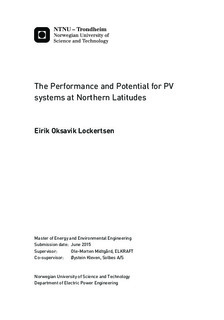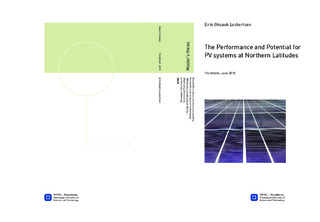| dc.description.abstract | What is the performance and potential for PV systems at northern latitudes, is the research question for this thesis. In order to answer this a literature review have been done and a case study of, and visit to, a 236 kWp PV system in Piteå, Sweden have been conducted. Simulations of this system have been done for average years, through extracted system data, and meteorological data, in order to compare to the actual performance of the system. The levelized cost of energy from the PV system have been calculated through a constructed tool. And the investment profitability in Norway have been investigated.
It was found that the quality of irradiation databases available for northern latitude is low. The best generic database found was the NASA/SSE. The low irradiation conditions in northern latitudes might have a negative effect on inverter performance. The optimal module tilt and azimuth should be based on snow accumulation in addition to solar geometry and irradiation composition
The simulation of the 236 kWp PV system gave a performance ratio of 0.850, specific production of 897 kWh/kWp, and an annual yield of 208 kWh. Although comparison between simulation based on actual weather conditions and reported delivered energy from the system suggests an inverter efficiency of 89.1 % instead of 96.3 % as suggested by the manufacturer.
The PV system LCOE was calculated to be 0.132 EUR/kWh. The cost level was found to be close to world best practice.
A scenario with a 15 kWp PV system for a private household in Norway gave a cost of energy from a PV system of 0.12 EUR/kWh, 0.02 EUR/kWh above the socket electricity price. Indirect revenues points to a higher value of PV electricity, making this the preferred choice.
There are some issues to be aware of, but the end conclusion is that the performance and potential for PV systems in northern latitudes is overall very good. | |

